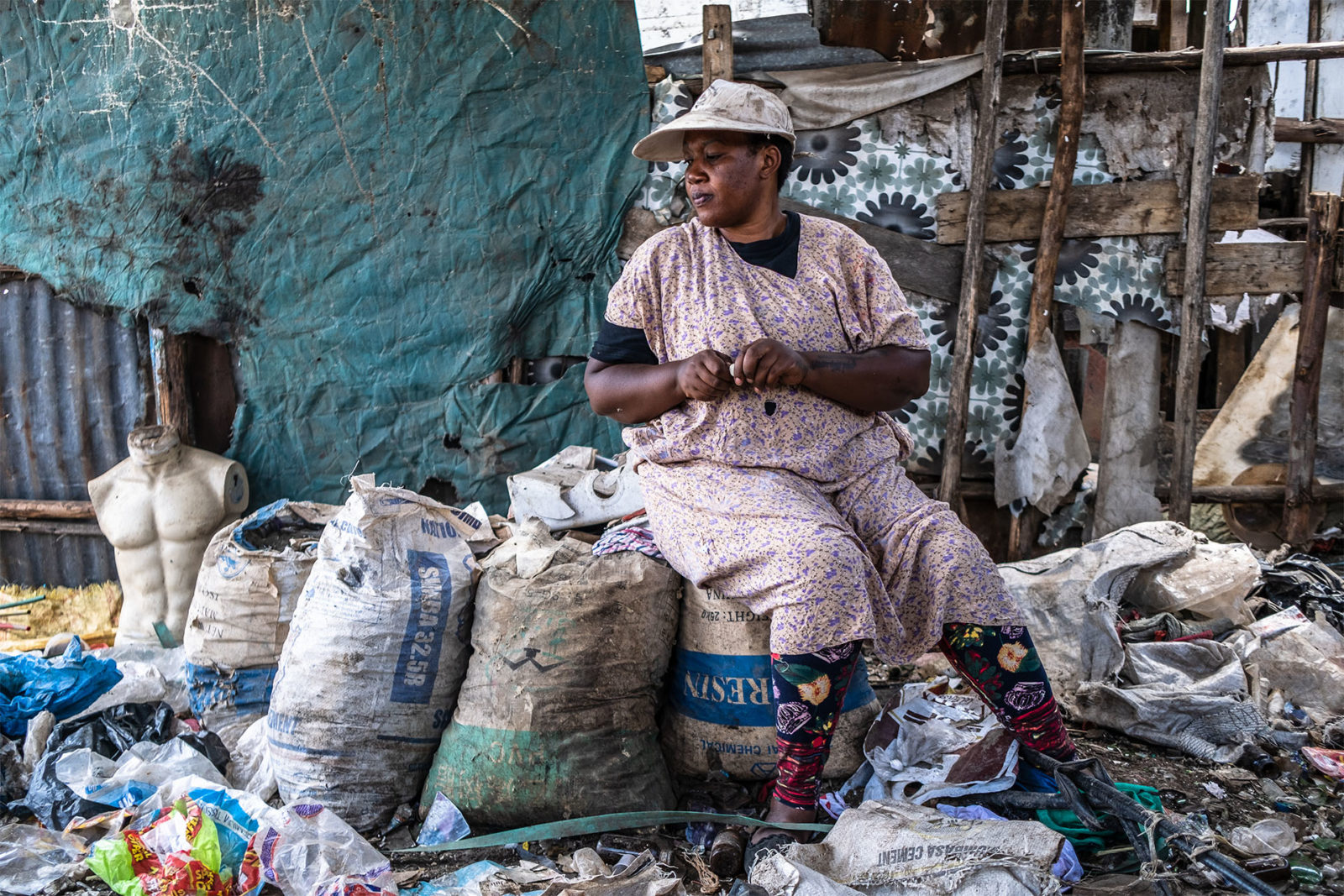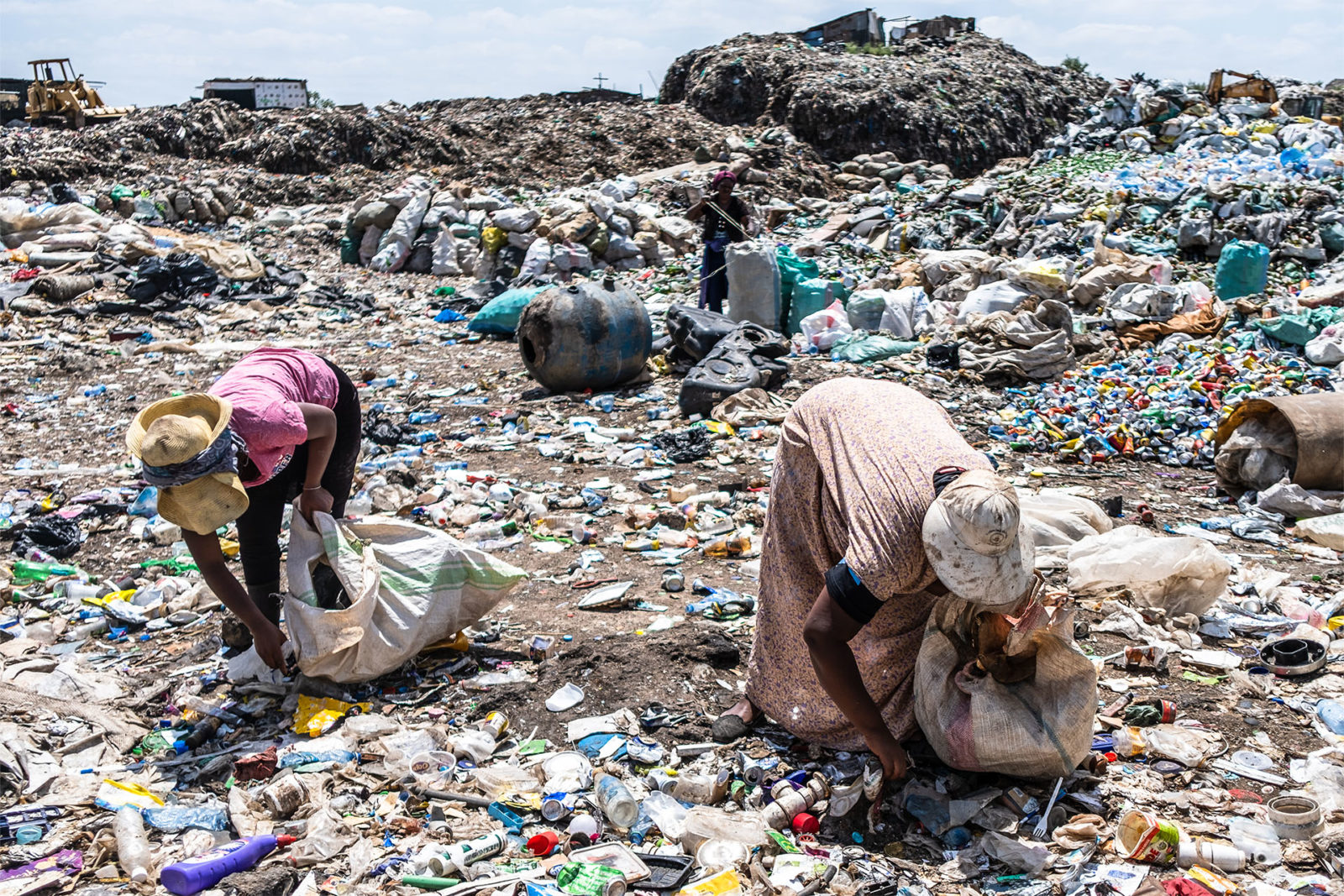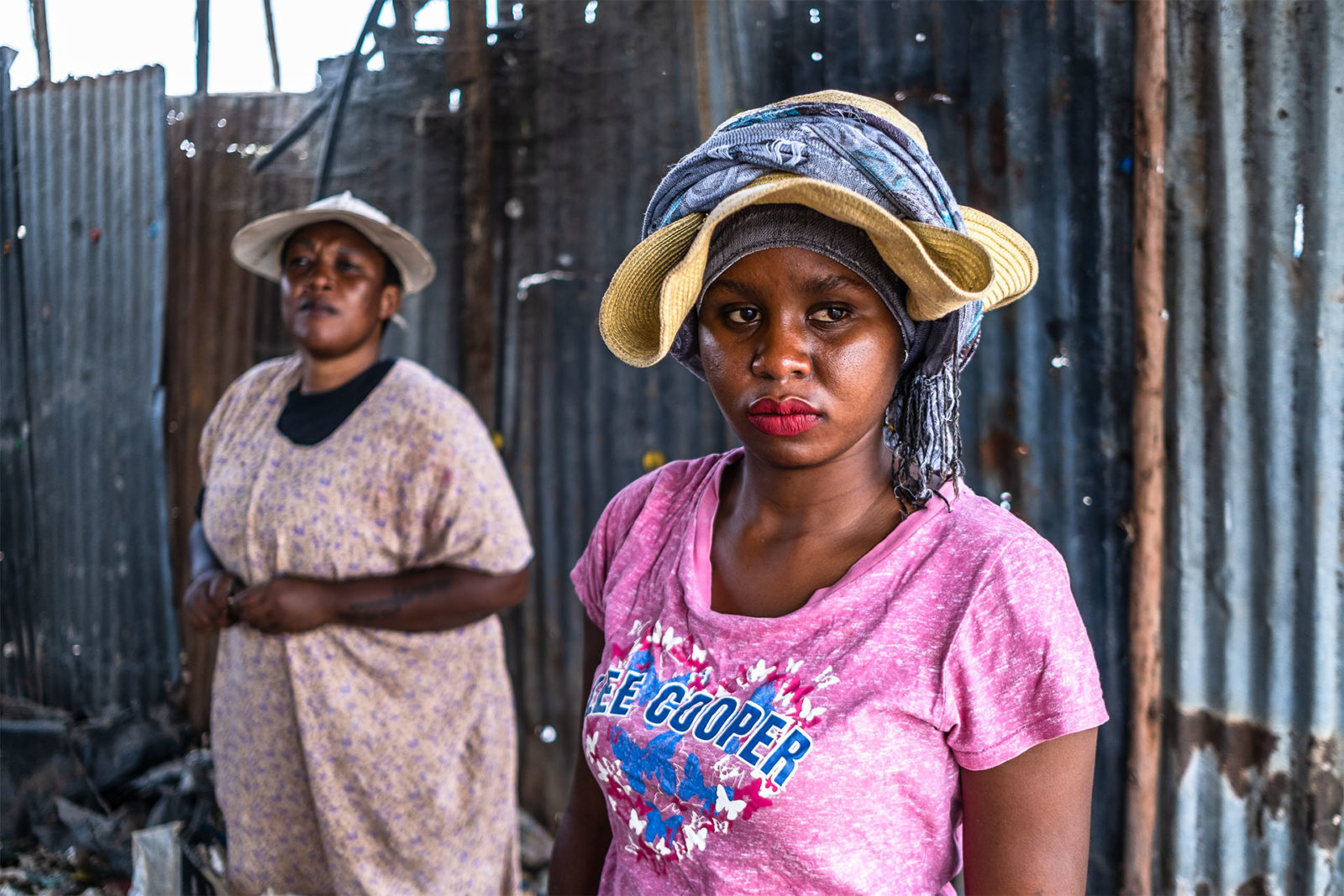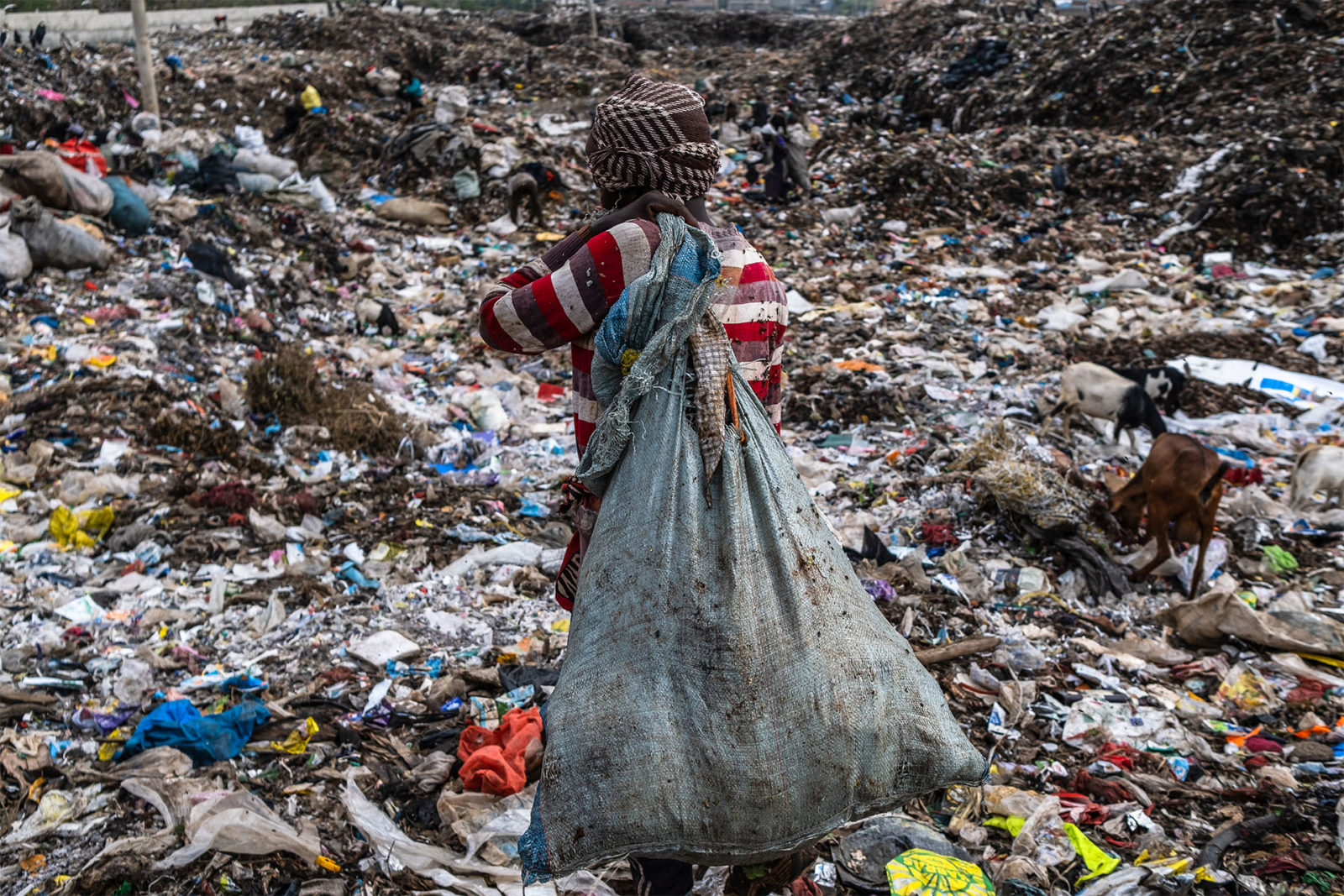DANDORA, Kenya– As Winnie Wanjira rifles through mountains of waste at the Dandora dump in Nairobi, it’s not the discarded needles that most bother her. Nor the metal scraps that could shred her skin like paper. It’s not even the hot sun that beats down on the rancid rubbish, making the 36-year-old feel so dizzy she struggles to fill her sack with plastic bottles.
Today, the mother of six is anxious about her period. It’s heavy, she says. So heavy she spent the last two days lying down in her windowless, single-bedroom home, unable to move. “The bleeding… is no joke,” she tells The Fuller Project and VICE World News. “I cannot come to work, I cannot go anywhere.”
Now, on the third day, she’s back, hoping the jumper tied around her waist will cover any stains. “And it’s, like, black, not even the normal colour of periods,” she says. “That place… It kills. It really kills.”
As far back as 2007, the United Nations Environment Program warned that Dandora posed a serious health threat to those working and living nearby. Yet while it is understood that exposure to the toxic chemicals found on dumpsites can result in cancer, respiratory problems and skin infections, scientists and environmental campaigners say relatively little attention has been paid to their impact on the reproductive health of waste pickers, who are often women. Materials such as plastic and e-waste contain a cocktail of chemicals that studies show can disturb the body’s hormone systems. As ever-higher volumes of trash continue to end up in landfills, informal workers like Wanjira will be on the front lines of what scientists are calling an emerging issue of global concern.

For years, acrid smoke has billowed across this sprawling dumpsite, which covers an area of the Kenyan capital the size of 22 football pitches. On windy days, clouds of smoke engulf the nearby neighbourhoods. “You can’t breathe,” a woman who works in a nearby pharmacy tells The Fuller Project and VICE World News.
It’s not just an issue at Dandora. Across Kenya’s dumpsites, a potentially toxic mix of everything from empty milk cartons to old tyres are being destroyed through open burning, according to a 2017 report by the government and the United Nations. Around the world, many of the estimated 20 million waste pickers in countries such as India, Ghana and Vietnam likely face similar health concerns. Estimates vary, but studies show this informal workforce is often mostly women.
“This is a global problem,” says Griffins Ochieng, executive director for the Centre for Environmental Justice and Development (CEJAD), a Nairobi-based nonprofit focusing on the problem of plastic waste. “Any dumpsite – anywhere there is plastic pollution – women will be impacted.”
This is because many materials that end up as waste contain toxic substances. Plastics and e-waste are known to contain and leach hazardous chemicals into the environment, including endocrine-disrupting chemicals (EDCs), which have been linked to reduced fertility, pregnancy loss and irregular menstrual cycles, among many other conditions. Burning them releases or generates a number of highly toxic chemicals and heavy metals, with reported similar effects. The toxins are not only in the air but also in the soil and water, and for the many waste pickers who eat from the landfills, in their food, too.
While men frequently take on more supervisory roles, women often spend the entire day rummaging, says Ochieng. “They’re in the thick of things… but the environment is a threat to their human health.”

Globally, the amount of trash we produce – and where to put it – is a growing problem. Each year, the world generates 2.01 billion tonnes of household waste, the equivalent of more than 6,000 Empire State Buildings being collectively chucked out every 12 months. By 2050, the number is set to rise by more than 70 percent. In low-income countries, over 90 percent of waste is either dumped in the open or burned.
It’s why waste pickers, like Wanjira, are often described as the backbone of waste and recycling industries. They’ve stepped in, an informal, often invisible workforce relied upon by governments in parts of Latin America and Asia and across Africa. Spending long days bent over, picking up and sorting waste discarded in streets and dumpsites, they recover more recyclable materials than formal waste management systems yet represent some of society’s most marginalised populations. In Kenya, roughly 3,000 to 5,000 waste pickers scatter across Dandora’s hills every day. Around the country, local organisations estimate the numbers reach nearly 50,000, although there is no official total.
If Wanjira’s heavy, painful period had been a one-off, she might have been a little less worried. But she’s faced the same issue – often twice a month – for roughly 20 years, she says. When Wanjira was about 13 and her family could no longer afford school fees, she dropped out and started working with her mother, Jane, who was also a waste picker. Within several years, Wanjira’s problems with her menstruation started, she says.
She’s not alone. In interviews with 32 women across Dandora and Gioto, another vast dumpsite in Nakuru, a three-hour drive from Nairobi, 21 women said their periods are irregular. Many, like Wanjira, face very heavy, painful periods once or twice a month. Others wait eight months for theirs. One in three say they have suffered serious issues when pregnant, including miscarriage, stillbirth and premature birth. About 10 to 15 percent of pregnancies worldwide end in miscarriage, according to March of Dimes, an organisation that works on pregnancy and postpartum health, while stillbirth and premature birth are much rarer.

One 59-year-old woman who has worked at Dandora for nearly three decades is being treated for uterine cancer.
“We hear these issues all the time,” says Joyce Wangari, a 23-year-old waste picker who has worked at Dandora since she was 12. She only gets her periods every two to three months. “It’s so common.”
There’s no definitive proof that the problems experienced by these waste pickers are caused by exposure to toxic chemicals, but it’s highly likely to be an underlying factor, according to Sara Brosché, science adviser at the International Pollutants Elimination Network (IPEN), a global network dedicated to eliminating toxic chemicals.
“The evidence is strong,” she says. “But the connection between toxic chemicals and impacts on women hasn’t really been talked about that much. It’s such an important but overlooked issue.”
In WhatsApp messages, Daniel Wainaina, chief officer for public health at Nakuru County, says waste pickers’ health is not individually analysed but that it would be “an interesting area for prospective studies.” He did not answer specific questions about the impact of toxic chemicals on reproductive health.
Neither the Nairobi county government nor the national governing body that oversees environmental policies replied to multiple requests for comment.
Doctors in several medical clinics near the dumpsites point out the workers’ choice of family planning likely plays a significant role. Many birth control options, including the pill, implants and intrauterine devices (IUD), can produce menstrual cycle changes. Genetics, nutrition and poor living and working conditions may also play a part. Most waste pickers handle trash without gloves or masks, and they often live near or on the dumpsites, which intensifies their exposure to health risks.
Yet one-third of those interviewed say a medical professional informed them their reproductive health issues either were or could be connected to their working environment. Some started picking trash as adults, and say they had no reproductive issues before then. Others say they aren’t using any contraception, or their problems persisted after they stopped taking the pill or removed the implant. Several say they started taking hormonal contraception with hopes of regulating their menstruation – often with little success.
“Before I came here, my periods were normal,” says one waste picker, whose name we are withholding due to safety concerns. “But then it came heavy, and so many times in a month.” She began picking trash when she was roughly 30 years old. Now 58, she is no longer menstruating, likely due to menopause. “But that smoke enters your body. You feel weak, so weak.
“Also the things that we’re sitting on,” she continues, pointing to the brightly-coloured bags filled with shreds of plastic film piled up beneath us. “They have chemicals in them. You never know if they affect you, but eventually you start feeling pain. In my chest, mainly, and around my abdomen and back. When I sit down, I feel like something very sharp is piercing me.”

Considered virtually worthless 20 years ago, plastic is now in high demand. Wanjira can sell a 1kg bag of plastic bottles to middlemen or traders for the equivalent of 13 cents (cotton, by comparison, sells for 2 cents). On a good day, she earns roughly $2.50; on a bad one, just 80 cents. As demand for packaged, mass-produced products has grown, plastic production has exploded, overwhelming the world’s ability to deal with it. Only 9 percent is successfully recycled, with the bulk ending up in landfill, incinerated or leaking into the environment, according to a report by the Organization for Economic Cooperation and Development. Unless action is taken to limit its use, plastic production and disposal are projected to triple by 2060.
“It’s completely out of control,” says Ochieng.
As plastics degrade into microplastics or are burned, people who live near dumping sites or the surrounding environment face health risks from toxic chemicals. These can include dioxins, mercury and polychlorinated biphenyls, or PCBs, which were banned in the US in 1979 and have been labelled probable carcinogens.
Yet studies indicate just how easily those chemicals can find their way into our food. At the world’s largest e-waste scrap yard, in Ghana, the unusable wires and spare plastic bits from old electronics are set alight. The eggs of chickens that foraged nearby contained the second-highest level of brominated dioxins ever measured, according to a 2019 report by IPEN. The chemicals can harm developing foetuses, interfere with hormones, and cause reproductive problems and cancer.

“Come,” says Wanjira, leading the way across a makeshift wooden bridge towards her home. The water in the river below is a murky grey, old plastic containers littering the banks. Inside, Wanjira’s mother, Jane, sits quietly threading small orange beads onto string. She now sells bracelets to earn money, having quit working at Dandora several years ago.
“I was constantly getting sick,” she says of her 40 years picking waste. Jane first started in the early 80s, several years before Wanjira was born. While her periods were never impacted, she says, she now suffers from diabetes, arthritis and high blood pressure.
Jane’s now in her early 50s, and it’s possible her health issues are age-related, says Pauliina Damdimopoulou, a senior researcher in chemicals and female fertility at the Karolinska Institutet, a medical university in Sweden.
“Maybe she would have gotten sick anyway,” says Damdimopoulou. “But it does sound like the environment is so toxic that most health issues could be attributed to it. How the toxicity manifests in individual cases is very hard to say.”
Related: Air pollution’s impact on women’s health is slipping under the radar, public health experts warn
For second-generation waste pickers like Wanjira, the health risks are greater, adds Damdimopoulou. As chemicals in the body of a pregnant or lactating person may transfer to a foetus or infant via the placenta or through breast milk, it’s possible they were exposed before they were even born, she says. And they could pass those chemicals on to their children. When exposure takes place early in life, either in the womb or during childhood, the health impacts can be worse because the body is still developing.
“And the longer you’re exposed to many of these chemicals, the higher the levels,” says Damdimopoulou. “My prediction would be that these women would be even more affected than the others.”
Twelve years ago, when Wanjira was pregnant with twins, she switched from picking trash deep in the dumpsite for a quieter job collecting plastic bottle tops along the edges. She felt a pressure in what she describes as her private parts, but tests from the hospital showed no issues, she says. After previously losing two pregnancies – one through miscarriage, the other a stillbirth – she decided to take it easy. Doctors had already told her toxins from the dumpsite were impacting her menstrual cycle, and she wanted to protect herself.
The twins arrived safely, but they have asthma. Another child has epilepsy, she says. She can’t afford the regular 4,800 Kenyan shillings ($41) for their inhalers, instead using those she finds discarded on the dumpsite. “I don’t look at the expiry date, which I know is risky.”
She remembers a doctor suggesting the twins were impacted in her uterus by the toxins she inhaled at the dumpsite. “But there is nothing I can do,” she says. “My kids must eat.”
Rita Mokhwana, a nurse in a nearby clinic in Dandora, said she wasn’t surprised by the problems the waste pickers faced. She estimates about half her patients work on the dumpsite. Miscarriages are a daily routine, and she treats three to four people a week with menstruation issues. The majority are not on birth control. “Mostly the cause is the dumpsite – the smoke, pregnant women overworking themselves,” she says.
Many waste pickers are reluctant to voice their concerns out of fear the county government could close the dumpsite. Most know the environment is not good for their health, but it’s their livelihood and a vital, if treacherous, lifeline. Since the Dandora site was declared full in 2001, there have been multiple efforts to clear the area — the latest in July last year, when a court ordered the county government to relocate the landfill to a more environmentally friendly site where waste is properly separated and recycled within six months. Yet the dump is still in operation. Every day, another 850 tonnes of waste from the city’s 4.3 million residents enters its overflowing walls.
As the leaders of the newly formed Nairobi Recyclable Waste Association, Wanjira and Wangari are organising on behalf of roughly 300 members to promote and protect the rights of waste pickers. Both women are currently hustling to recruit new members. The larger the group, the more their legitimacy and bargaining power grows when calling on the government for safe and healthy working conditions, says Ochieng of CEJAD.
“We don’t fear to take a stand because we represent the waste pickers,” says Wanjira. “If the government tries to kick us out, we can run to court and say we have rights, we work here, where do you want us to go?”

If the waste pickers in Kenya want to demand change, they’ve timed it well, says Ochieng. Two months ago, world leaders met in Nairobi and agreed to develop the first-ever global treaty that would restrict the growth of plastic pollution. The aim is to not only improve recycling methods and tackle the world’s plastic waste problem but also put curbs on plastic production.
The details will be hammered out over the next two years, but Ochieng is hopeful. For the first time, the new agreement formally recognised the significant contribution of waste pickers in the plastics economy. While it’s not yet clear how much will change, a new waste management bill in Kenya pushing for households to segregate their trash also represents a shift in thinking – one where reusing, repurposing or recycling materials is prioritised over simply throwing away.
“And the waste pickers need to be part of these formal conversations,” says Ochieng. “That’s the idea around their organising… Someone has to fight for their role.” Back at Dandora dump, Wanjira is flicking through a pile of crumpled papers ripped out from a textbook. On each side, a list of women’s names runs from top to bottom – her latest recruits to the waste picker association from a nearby dumpsite. “I signed up 70 mamas the other day,” she says, smiling. She is nervous, though. She thinks the government will chase her away if she complains about the air pollution.
“But I am not the only one. Women on the dumpsite are suffering. They need our help… their stories need to be heard.”
Additional reporting by Eriss Khajira


